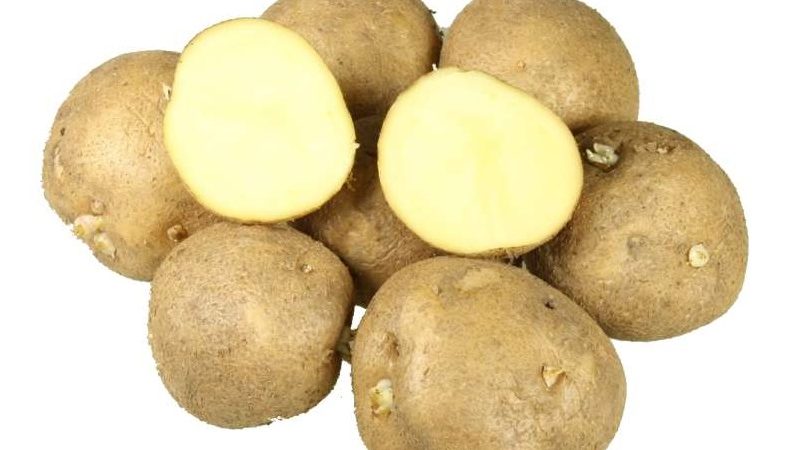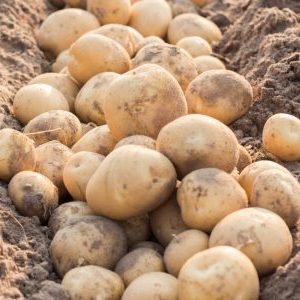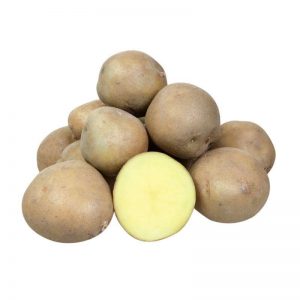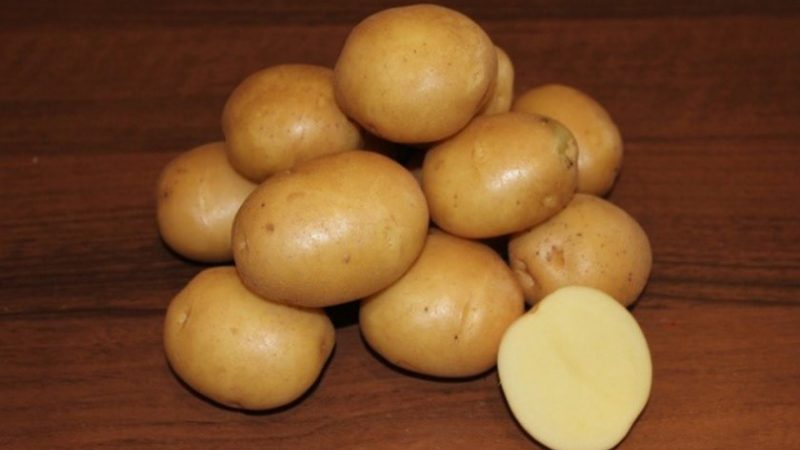What is the good potato variety Kolobok and why gardeners love it so much
The correct choice of potato variety is the key to an excellent harvest. In this article, we will tell you how Kolobok differs from other varieties of potatoes, why it is so popular among farmers who grow it for personal use and on an industrial scale for sale, and also find out what difficulties you can face when growing this variety and how to handle them. cope.
The content of the article
What kind of potato is this
Potato Kolobok has a pleasant rounded shape, yellow flesh and skin. It belongs to mid-season table varieties.
The growing popularity of Kolobok is due to its rich vitamin composition and excellent taste. It does not boil soft, has a delicate taste, perfectly manifests itself as an independent dish when baked in foil, frying and any other cooking methods.
Gingerbread man is unpretentious and requires no more maintenance than other varieties of potatoes. It does not darken for a long time on the cut. Moreover, it contains less starch than other yellow varieties.

It is interesting! The yellow color of the pulp indicates a high content of provitamin A and carotenoids. There are quite a few of these useful substances that prevent aging and many diseases in ordinary "white" potatoes - about 250-2000 mcg per 1 kg. However, in yellow varieties it is 3-5 times more, which, taking into account also the low starch content, makes Kolobok very attractive for those who try to eat well and properly.
Origin and development
Potatoes Kolobok bred by Russian breeders from the agronomic center "Korenevo" and VNIIKH them. A.G. Lorkha. It was registered in the State Register in 2005.
Despite the fact that scientists advised farmers to grow Kolobok in regions with black earth soil, it is also in demand in the north-west of Russia (in the Leningrad region), as well as in other regions and neighboring countries.
Distinctive features, appearance
Kolobok differs from other yellow varieties:
- a small number of eyes;
- lack of bumps and bumps;
- rough and dense skin - thanks to it, the potatoes are more resistant to damage, better retain their shape;
- pale yellow uniform skin color;
- tuber weighs about 90-150 g;
- low starch content - about 11-13%, so potatoes will not boil over, crumble and turn into porridge during cooking.
Those who grow the Kolobok on an industrial scale note the excellent presentation and excellent transportability. Potatoes are well stored, the main thing is to dry them thoroughly after harvesting and find a cool and dry room for this.
Description and characteristics of the variety
The gingerbread man belongs to medium-sized varieties: the aerial part of the bush grows no more than 0.5 m. The color of the leaves is light green. The flowers blooming on the bush during flowering are white. Semi-upright bush, medium height, intermediate type.
The branches of the bush are not too spreading, the average number of leaves is small, veins are pronounced on them, and the edges are slightly wavy. This planting looks very attractive, especially when flowering.
Yield
From one kolobok bush, 10 to 18 potato tubers are harvested. The yield is about 25 tons per hectare of land - another advantage of the variety.
Gingerbread man ripens within 3 months after planting. Eating young potatoes begins in mid-July (provided that they are planted in early May). It is customary to harvest completely in mid-September, when the Kolobok reaches its maximum technical maturity and size. The stems signal that the potatoes are ready for digging - they begin to dry out.
It is interesting! One of the significant advantages of the Kolobok variety is its resistance to degeneration and a decrease in yield, even if it is planted in the same place for many years.
How to grow this variety
As with other types of potatoes, getting a good harvest requires:
- Prepare a place for future landings: weed, dig up and fertilize the soil. Any preferred options will do for this. top dressing - both organic and mineral.
- In the spring, plow the area shallowly for potatoes and pull out the weeds.
- After plowing, add potash and phosphate fertilizers.
Timing, scheme and landing rules
To accelerate ripening, it is better to plant potatoes in well-heated soil. The temperature at the bottom of the potato hole (slightly less than the bayonet of a shovel, about 12-17 cm) should rise to + 8 ° C. In most regions of Russia, the soil warms up by mid-May.
For optimal illumination, the rows are arranged in a line from north to south. The distance between the holes is about 30-40 cm, and the gap between the rows is at least 60 cm.
It is important to follow other rules:

- Before planting, germinate the tubers in the light, selecting the most beautiful and strong, medium sized tubers. The sprouts emerging from the eyes should reach 2-3 cm in length by the time of planting. This takes about a month.
- Plant potatoes in moist, but not waterlogged soil.
- Make the beds high if the groundwater in the area is close to the ground.
- It is better to plant the tuber whole, without cutting. So it will be more resistant to pests and diseases.
- Not sparing a handful of humus (compost) and ash for each hole, later you will harvest a richer crop than without such feeding at the planting stage.
Care
Timely weeding, hilling and watering during flowering - these are all the basic rules for a good harvest of Kolobok.
The first hilling is performed when the bushes grow up to 25 cm in height. The next one is in 2-3 weeks. Water the potatoes during flowering. If the summer is dry, then during flowering potatoes are better "sprinkled" from a watering can or other convenient methods. The water should not be too cold.
When the potatoes have bloomed, stop watering so as not to harm, creating an attractive moist environment for the development of various diseases.
The Kolobok is fed 2-3 times during the summer season. He prefers potash mineral complexes, mullein or chicken droppings. But nitrogen-containing fertilizers will cause a rapid growth of green mass. It is better to alternate organic and mineral dressings.
Important! The first feeding is carried out when the sprouts reach 20-30 cm in height. It can be combined with the first hilling. The second - before or during flowering, the third - a few weeks after the second to improve the growth of tubers formed during flowering.
The nuances of growing and possible difficulties, diseases and pests
Subject to the planting deadlines, the rules for the preparation of tubers, timely hilling and regular weeding, as well as fertilizing with fertilizers, there are no difficulties with growing this variety.
The most common diseases of the variety:
- Alternaria (dry spot) - looks like small dark spots on the tops, this fungal disease is defeated by drugs such as Albit, HOM, etc.

- Potato nematode... A sign of this pest, hiding under the ground and invisible to the eye - “bald spots” in the field, when some of the bushes develop poorly and turn yellow. Nitric acid fertilizers (urea, etc.), as well as compliance with crop rotation, will help to cope with the problem.
- Late blight (brown rot) - it is easy to recognize the presence of this disease by withering, gray potato shoots and drying tops. You can cope with this misfortune with the help of an infusion of garlic, a mixture of copper sulfate with boric acid and potassium permanganate, or with the chemical preparations Fitosporin, Epin, etc.
At the first signs of these diseases, the bushes are treated with preparations containing copper.
Gingerbread man is also loved by all common pests: Colorado potato beetle, wireworm, scoop and others. Plant next to potatoes plants that will repel insects (marigolds, wormwood, etc.) or treat bushes with chemicals.
Important! To eliminate the risk of contamination of the potato plantation, treat the soil with insecticides or special preparations that improve its composition. An excellent solution is to periodically change the growing place. During rest, the ground is planted with green manure plants that improve the composition of the soil - mustard, phacelia, amaranth, calendula, marigolds.
During dry periods, the Kolobok is watered, especially if the drought occurs during flowering. The best solution is drip irrigation, but if it is impossible to organize it, the usual one will do.
Collection, storage and use of the crop
Mass harvest of potatoes Kolobok begins 95-115 days after planting. It is advisable to dig it up on a warm, dry day. It is allowed to use a motor cultivator and other equipment.
After harvesting, the potatoes are laid out in a dry, light place to dry. It is recommended to sort, setting aside seed, table and damaged in separate groups.
Important! Medium Kolobok tubers are chosen for seeds - they are more resistant to pests and diseases.
After drying, the potatoes are stored in a cellar or basement. It is better to put it in wooden boxes, pre-treated with a solution of potassium permanganate. The optimum storage temperature is about + 10-12 ° С, humidity is no more than 85%.
The gingerbread man is perfect for cooking any kind of food, including fried potatoes, chips and French fries, as it keeps its shape perfectly.
Advantages and disadvantages of the variety
High yield, even shape, excellent taste, a large amount of vitamins make Kolobok one of the best varieties.
Farmers appreciate its unpretentiousness and resistance to diseases such as rhizoctonia and scab. Heat and drought are also not terrible for Kolobok, especially if it is watered. Its transportability is almost lossless (during transportation, about 98% of the total mass is retained) makes it one of the most promising varieties for commercial enterprises.
The disadvantages of Kolobok include its instability to wireworm, Alternaria and late blight. However, with timely treatments for pests and diseases, such troubles can be avoided.

Which regions is best suited for
When creating the variety, breeders noted that it is best to grow potatoes Kolobok in the Central and Central Black Earth regions. In practice, its popularity has gone far beyond these territories.
It is interesting! Regions with black earth soil in Russia are Voronezh, Belgorod, Kursk, Tambov, Lipetsk regions. There are such fertile lands in the Samara, Saratov, Sverdlovsk, Kemerovo, Chelyabinsk, Omsk, Orenburg regions and Krasnodar Territory.
Farmers reviews
Farmers speak positively about the Kolobok variety, noting its excellent taste, beautiful round shape and excellent keeping quality.
Julia, Leningrad region: «The potatoes were larger than average, there were almost no trifles at all. Very beautiful and even tubers, looking at him, I understood why they called him Kolobok. I also really liked the taste of the potatoes, and the color is yellow and beautiful. "
Anna, Krasnoyarsk Territory: “The gingerbread man is not very large, but in large quantities, more than 15 pieces per bush, clean, healthy, practically without wireworms. The pulp is yellow, the taste is excellent. "
Alexander, Rostov region: "Kolobok is a variety with excellent keeping quality. Even closer to spring, it is still dense and juicy, does not deteriorate and does not wither. I grow potatoes for myself and for sale, so I consider it important not only to grow, but also to keep the crop in a proper condition for sale. There are varieties that are more productive than Kolobok, but it is stored the best. That is why I have a positive attitude to the variety and recommend it to everyone. "
Read also:
The use of potato starch in folk medicine and in everyday life.
Conclusion
When growing the Kolobok variety, it is important to observe several basic rules for preparation, planting, care and collection: select the best seed tubers, perform the first hilling and feeding on time, as well as treatment against pests. Since feeding for this potato variety is required only 2-3 per season, its cultivation is less of a hassle - hence the popularity of Kolobok.
Gardeners appreciate this tasty, healthy and well-preserved potato variety, suitable for all culinary purposes.